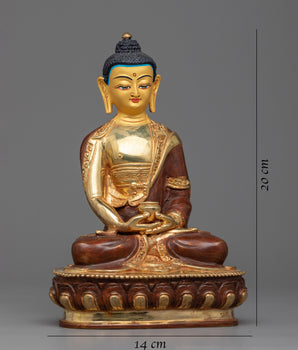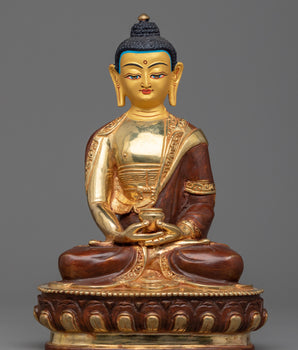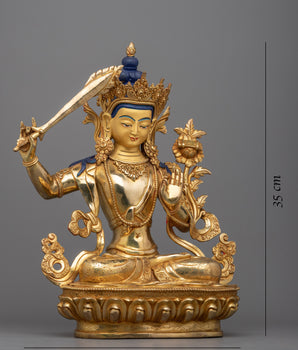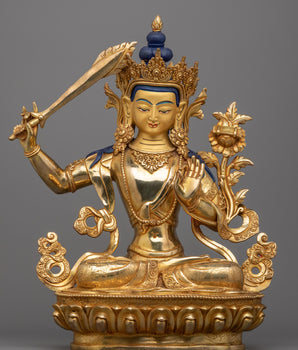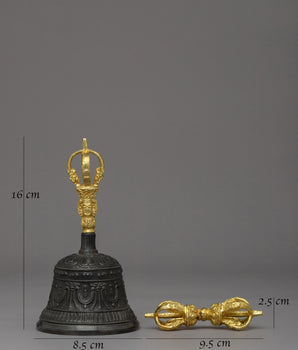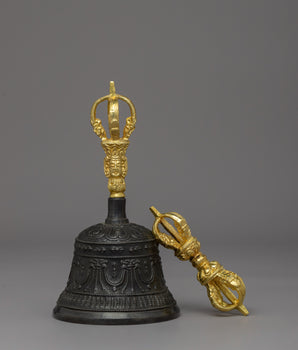From Elephants to Enlightenment: The Journey of the Ankush Through Buddhist Rituals
In Buddhist artistic and ceremonial traditions, the Ankush (elephant goad or hook) symbolizes the spiritual progression through its classification as a powerful metaphor. The Indian religious tradition transformed this animal-control device into a representation of mental training and dominance as well as enlightenment and liberation. For Buddhist followers following Vajrayana and Yoga Tantra practices, this ritual item has a religious significance that far exceeds its physical form. In religious practice, this allegorical object becomes a holy symbol for practitioners to control their uncontrollable thoughts and use awareness to attain spiritual enlightenment.
The enlightened mind manifest through sacred artwork as the hook symbol because it exists both as a contemplative weapon which acts precisely with determination to guide uncontrollable mental dilemmas. The Ankush as seen by deities Vajraraja and Vijaya, as well as Samatha thangkas and ancient Buddhist scriptures embodies the necessary dual qualities of compassion and control to reach liberation.
Through an examination of Buddhist traditions this blog aims to reveal the numerous meanings behind the elephant goad that illustrates its significant spiritual value throughout ancient tantras and meditative meditation.
Historical Significance of the Ankush
The Ankush remains an important cultural artifact in India for hundreds of years because it helps mahouts maintain control of elephants. The elephant control tool featured a hook jointed onto a handle which enabled effective elephant navigation by mahouts during steerable operations. The archaeological discoveries at Taxila between the 3rd century BCE and the 1st century CE have revealed excellently preserved elephant goads which showcase the prolonged historical presence of these tools in the subcontinent.
The elephant goad achieved sacred significance beyond its original use in Buddhist traditions as artists and religious practitioners started to use it in their ritualistic artwork. Different art forms demonstrate how the object became integrated within the cultural framework of ancient Indian religious beliefs.
The Ankush in Hinduism: Symbol of Divine Authority and Mental Discipline

Ankush in Hinduism continues to symbolize two main aspects which include divine mastery over oneself and divine direction of internal and external forces. The tool developed from elephant control instrumentation into an emblem representing spiritual command of mental and sensory direction. The conscious Anukush controls strong elephant characteristics to focus them on the religious path and spiritual advancement.
Among all figures associated with the elephant hook in Hindu beliefs, Ganesha stands as the most prominent because he carries it in one of his numerous hands. The power of Ganesha to lead followers toward wisdom by eliminating confusion and mental stagnation is symbolized by his Ankush, which serves as his obstacle-removing tool. Within tantric practices, Lalitā Tripurasundarī demonstrates her authority of cosmic illusion and desire through her hook while also using a noose to control forces of attraction and repulsion. Various deities like Yama and fierce Devi manifestations are shown holding the elephant goad, which strengthens their links to karmic governance and religious disciplines.
Despite variations across cultural contexts the Ankush symbolizes mental control equally within both Hinduism and Buddhism. Natural liberation demands conscious direction while facing the emotional forces residing within us according to both Buddhist and Hindu traditions.
Mythological Significance and Symbolism in Buddhism
According to Buddhist teachings the elephant symbolizes the human mind because of its simple definition as a powerful wandering force. The Ankush functions as an instrument which helps guide people to direct their minds for achieving focused awareness and spiritual enlightenment. In spiritual practice disciples need mindfulness and discipline which matches the mahout's expert conduct of an elephant.
The object embodies several layers of meaning:
-
Control over the Mind: Practitioners who utilize the tool use it to guide their thoughts and emotions with purpose in the same way that mahouts use the goad to control elephant behavior.
-
Spiritual Guidance: Through its function the tool functions as a memory tool which reveals enlightenment-based guidance that protects practitioners on their spiritual journey by directing them from ignorance towards wisdom.
-
Authority and Power: The hook symbolizes mastery of inner faculties as well as attaining spiritual authority to all who hold it.
Iconography of the Ankush in Buddhist Art

-
Intricate Design
The elephant goad is frequently depicted as a laboriously decorated ritual tool, reflecting its deep, what seems to be, sacred identity within the sphere of Buddhist iconography. The intricate workmanship indicates caring for tools that have both practical and symbolic spiritual uses. -
Makara Motif
A unique feature of many designs of the Ankush is a hook that is found coming out of the mouth of a Makara, a mysterious sea creature myth that is also often associated with water and an elemental state of energy. Within Buddhist symbolism, this is an extension of the practitioner's ability to bring wild, untamed, chaotic energy under control. The presence of the tool inside the jaws of the Makara represents this, closely controlled or directed action with discerning awareness. -
Handle Symbolism
The handle of the Ankush is traditionally decorated with half-vajras or full vajras, symbols of indestructible strength and spiritual power. This places the tool in direct relation to the indestructible, strong clarity of the enlightened mind, going beyond simply control, to empowered transformation. -
Material and Craftsmanship
Ritual elephant goads are typically made of bronze, silver, or gold and are frequently embellished with gemstones or decorative images, such as flames or lotus petals. The “luxurious treatment” enhances the cosmological images of deep royal and spiritual power associated with the Ankush, as well as its significant role in the use of the trident during tantric rituals.
Each aspect of Ankush's design reflects basic Buddhist teachings. This object exemplifies the effort to tame and teach the mind, stabilize and transform energy into awareness and even locate resilience to follow the path of enlightenment. The tool is much more than a simple instrument; it serves as a deep visual symbol for the spiritual path.
Deities Associated with the Ankush
The Ankush serves as a visual message of the control and protection the deity holding it represents and the guidance these honorable emanations offer practitioners. An elephant goad held by a deity is understood to bestow an empowering ability upon its followers and protégés, much like a handler directs an elephant in a manner towards safety and a purpose. The elephant goad is commonly referred to in Hindu association, though several Buddhist traditions connect it to certain figures:

Anantavijaya Holding Ankush
(Photo From Himalayan Art Resource)
-
Rigden Namgyal (Vijaya): He is known as one of the "Twenty-Five Kulikas" and the fourth king of legendary Shambhala. He is presented with an Ankush to signify its association with all that it symbolizes concerning righteous authority and steering beings unto awakening.
-
Rigden Thaye Namgya (Anantavijaya): Another of the "Twenty-Five Kulikas" and the twenty-fourth king of Shambhala, Anantavijaya is depicted as a divinity with an Ankush, denoting the disciplined control of the mind and the triumphal announcement of Dharma.
-
Vajraraja: A deity in the Vajradhatu mandala also depicted with an Ankush, signifying authority and the ability to control inner defilements.
-
Ganapati: Though primarily a Hindu deity, Ganapati is revered as a Bodhisattva in Buddhism and called the "remover of obstacles," and the hook is represented in some Hindu art and context. This notion of Ganapati removing obstacles, particularly in syncretic cases like Newar Buddhism and also in some Tibetan schools, has led to some depictions of Ganapati represented with his antrush and other attributes emphasizing his role in addressing mental and spiritual obstacles.
Depiction of the Ankush in Samatha Meditation Thangkas
In Samatha meditation thangkas, the elephant goad is an important symbol that traces the meditator's journey towards a calmer mind. These thangkas visibly show the nine levels of mental development. The stronger the practitioner is, the less turbulent the elephant is as it transitions toward a state of calmness within practice.

-
Symbolism of the Ankush: The monk's use of the elephant goad represents introspective vigilance, or the practitioner's ability to enhance their awareness when awareness becomes disturbed from practice, enabling sustained awareness. The monk then uses the goad to periodically direct the elephant, symbolizing introspective vigilance, in transitioning the mind towards calmness.
-
Stages of Meditation: In the initial stages, the elephant (mind) is led about by a monkey, representing distraction. With further practice, the monk begins to acquire some degree of control over the elephant, or the practitioner establishes clearer control over what distracts awareness. Ultimately, the elephant becomes calm and obedient, or the mind recognizes the ultimate stabilization of awareness within the Samatha or peaceful abiding state of mind.
By embracing these symbols in the thangkas, Samatha meditation emphasized that both mindfulness awareness (rope) and introspective vigilance (hook) are necessary in achieving meditative stabilization. The object provides a visual reminder of the effort involved not only being aware / present but that attention and vigilance is required in order to be stabilized in awareness of mind that attains calmness.
The Ankush in Daily Practice
For today's Buddhist practitioners, the Ankush represents a metaphor about mental discipline and the poise of spirituality. Although it is seldom used in modern daily rituals or ceremonies, its symbolism is present in many forms of mindfulness-based and meditative techniques:
-
Meditative Focus: Practitioners are often instructed to "goad" their minds back to the present whenever distractions arise, similar to the elephant being redirected by the Ankush.
-
Ethical Conduct: The Ankush punctuation or bent line indicates the importance of restraint and ethical conduct, anchoring the practitioner in the role to make wise or compassionate choices.
-
Spiritual Aspiration: By bringing to mind the Ankush, one may be compelled to steer one's own journey towards enlightenment (and not just take it out of convention or habit).
The Ankush in the Tattvasamgraha Tantra
The Ankush assumes a subtle but symbolically influential role within the Tattvasamgraha Tantra (circa 7th century CE), a cornerstone text of the Yoga Tantra order within the larger history of Vajrayana Buddhism. The Tattvasamgraha Tantra provides a complex visualization of the Vajradhatu Mandala, among the most purified, stylized, and elegant mandalas in the tradition.
In this mandala, the Ankush appears as a symbolic attribute of the Bodhisattva Vajraraja, an important figure in the retinue of Vajradhatu (the Diamond Realm). Vajraraja is envisioned as radiating the power of wisdom in control, and the augmented psychic force of the elephant goad in his depictions parallels this— a vehicle to harness the mind and guide beings to awakening.
The Ankush appearing as it does in the Tattvasamgraha Tantra demonstrates how culturally entrenched the symbol is in nearly all aspects of the philosophical beliefs and meditative dimensions of Buddhist Tantra—how the ritual, deity practice, and the inner achievement of control of his mind connect to form an embodied experience of inner awakening.
Ankusasana: The Yogic Posture of Control and Focus

In the practice of yoga, there is a pose that is called Ankusasana (the Elephant Goad Pose). It is not as common or referred to in contemporary yoga classes; however, it has metaphorical depth related to the meaning of Ankush in Buddhist and spiritual thinking.
What is Ankusasana?
Ankusasana (अङ्कुशासन) combines two words in Sanskrit, Ankusha (elephant goad), and Asana (pose or seat). The pose is usually done in a seated, cross-legged position, or an upright seated position with the legs extended, with a straight back and hands on knees or thighs. The emphasis is on stillness, control of the breath, and focus inward, which is similar to the way an elephant goad guides a powerful force with the least amount of movement.
In different yogic philosophies, Ankusasana is described as a mediation pose that develops self-control over impulses in the body and mind, the way a goad helps settle the wild nature of an elephant; Ankusasana is not the end but rather a preliminary meditation to get to the self-control stage that one can consider spiritual development.
Symbolic Connection to the Ankush
The pose is more than just physical; it is an expression of mental discipline, calmness, and direction. When one practices Ankusasana, one is encouraged to:
-
Harness their inner strength (the elephant),
-
Cultivate mindful control (the goad),
-
And remain rooted in awareness (the meditative seat).
This triad of symbols embodying Ankusasana makes it not just a yoga posture, but a ritual in itself, replicating the internal work referenced in the Buddhist context.
Relevance for Buddhist Practitioners
While based more explicitly on yogic ideas, the three components associated with Ankusasana reflect Buddhist mindfulness and meditation practices. Practitioners looking for options for samadhi (concentration) or refining their sati (mindfulness) may find insight into the Ankusasan ideas even if they are not modeling the body pose.
At its core Ankusasana is a physical metaphor of what the Ankush suggests: a gentle but firm coercive movement of consciousness towards insight, stability, and an eventual liberation.
Conclusion

Although it is small in scale, the Ankush has tremendous symbolic weight in terms of Buddhist ritual and visual culture. The object appears in every thangka, in every mandala, and in every tantra, speaking on its behalf for a profound, collective message: the mind is powerful, but must be guided. Just like an elephant must be led with care and precision, the mind must also be delicately and firmly directed on the path of awakening.
When held by a deity, the hook becomes a divine working of karmic command and transformative power. When held by a meditating monk, however, the Ankush symbolizes vigilance and clarity. And as this practiced and disciplined gesture captures the practitioner's attention, it calls to the attention of practitioners that enlightenment is not a passive state—it is an enactment of effort, control, and volition.
When the practitioners see the elephant goad or sit to meditate with the intention, they are asked to consider the movement along their internal path. Are we allowing the elephant of the mind to mill about without purpose? Or are we gently directing the mind in order to take it into insight, peace, or release? The Ankush calls one to take the reins, to hold their intention with wisdom, compassion, and resolve.






